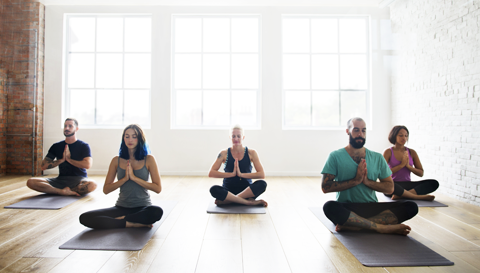At 8:00 am every Friday morning about five women sit quietly on their yoga mats waiting for class to start.
Pushed into the next room are hairstylist’s chairs, blow dryers, hair color and other assorted items used in a hair salon. The owner of the salon, another stylist and even a few clients don’t mind the décor, they are here for the yoga.
I just feel so much better when I do yoga,” said Kerri Ellis, owner of Salon 76 in Tennessee. “Standing all day long doing hair, bending over the washbowl and moving equipment takes a toll on my body. The yoga really keeps me strong and able to keep working.”
From small businesses in little towns to major corporations across America, yoga in the workplace is becoming more common and more accepted.
A recent New York Times article by David Gelles, At Aetna, A C.E.O.’s Management By Mantra, discusses how health insurance company Aetna, along with many other companies, are not only incorporating wellness programs into their workplaces, but also reaping the benefits as well.
More than one-quarter of the company’s work force of 50,000 has participated in at least one class, and those who have report, on average, a 28 percent reduction in their stress levels, a 20 percent improvement in sleep quality and a 19 percent reduction in pain. They also become more effective on the job, gaining an average of 62 minutes per week of productivity each, which Aetna estimates is worth $3,000 per employee per year. Demand for the programs continues to rise; every class is overbooked.
Gelles says the benefits Aetna is seeing in offering their employees yoga and meditation is also being documented in companies such as Google, General Mills and Goldman Sachs. He says the programs are designed not just to improve employees’ health, but also to help employees be more present minded, less likely to make rash decisions, and even get along better with coworkers.
Aetna brought in outside experts from the American Viniyoga Institute and eMindful to help develop their mindfulness programs. They also teamed up with the Integrative Medicine Program at Duke University to measure workers’ heart rate variability and cortisol levels, which are common measures of anxiety.
One third practiced Viniyoga, one third took a mindfulness class, and the rest were assessed as a control group. At the end of three months, the data came in, and executives were astounded. All employees who stuck with either the yoga or the mindfulness reported significant reduction in perceived stress and sleep difficulties. And while self-reports of lowered stress are not always reliable, the study also found that physical measures of heart rate variability and cortisol levels had both decreased.
Gelles said that although the initial program began with just 239 Aetna employees, after seeing the results, the program soon expanded across the country to thousands of employees. Aetna’s employee health care costs are consistently three percent lower than they were before the yoga and meditation classes were offered.
The American Institute of Stress says that more workers report health complaints associated with job stress than with financial or even family problems. Government reports also say the average workweek has grown from 40 hours in the 1990s to as much as an average of 49 hours currently. Poor compensation and increased workload are often cited as the reasons for work-related stress issues.
Yoga has long been proven to decrease stress levels so it seems natural to introduce yoga into what can be a stressful situation. The company benefits with lower absenteeism and lower health care costs. Yet the employees reap many benefits as well:
- Improved concentration and decision-making skills
- Pain relief from repetitive motion injuries, heavy lifting and even long sedentary periods
- Enhanced mental outlook leading to a better customer service attitude
- A feeling of well-being in the workplace and of being valued
Kerri says despite working a 12-hour day on her feet every Friday, it’s her favorite day of the week. Thanks to starting her morning with yoga, she has the physical stamina and the mental fortitude to get through her workday.
From: Yoga U



